Related Research Articles

Erosion is the action of surface processes that removes soil, rock, or dissolved material from one location on the Earth's crust and then transports it to another location where it is deposited. Erosion is distinct from weathering which involves no movement. Removal of rock or soil as clastic sediment is referred to as physical or mechanical erosion; this contrasts with chemical erosion, where soil or rock material is removed from an area by dissolution. Eroded sediment or solutes may be transported just a few millimetres, or for thousands of kilometres.

Geomorphology is the scientific study of the origin and evolution of topographic and bathymetric features created by physical, chemical or biological processes operating at or near Earth's surface. Geomorphologists seek to understand why landscapes look the way they do, to understand landform and terrain history and dynamics and to predict changes through a combination of field observations, physical experiments and numerical modeling. Geomorphologists work within disciplines such as physical geography, geology, geodesy, engineering geology, archaeology, climatology, and geotechnical engineering. This broad base of interests contributes to many research styles and interests within the field.

In geomorphology and geology, a peneplain is a low-relief plain formed by protracted erosion. This is the definition in the broadest of terms, albeit with frequency the usage of peneplain is meant to imply the representation of a near-final stage of fluvial erosion during times of extended tectonic stability. Peneplains are sometimes associated with the cycle of erosion theory of William Morris Davis, but Davis and other workers have also used the term in a purely descriptive manner without any theory or particular genesis attached.

Terrain or relief involves the vertical and horizontal dimensions of land surface. The term bathymetry is used to describe underwater relief, while hypsometry studies terrain relative to sea level. The Latin word terra means "earth."

Walther Penck was a geologist and geomorphologist known for his theories on landscape evolution. Penck is noted for criticizing key elements of the Davisian cycle of erosion, concluding that the process of uplift and denudation occur simultaneously, at gradual and continuous rates. Penck's idea of parallel slope retreat led to revisions of Davis's cycle of erosion.
Denudation is the geological processes in which moving water, ice, wind, and waves erode the Earth's surface, leading to a reduction in elevation and in relief of landforms and landscapes. Although the terms erosion and denudation are used interchangeably, erosion is the transport of soil and rocks from one location to another, and denudation is the sum of processes, including erosion, that result in the lowering of Earth's surface. Endogenous processes such as volcanoes, earthquakes, and tectonic uplift can expose continental crust to the exogenous processes of weathering, erosion, and mass wasting. The effects of denudation have been recorded for millennia but the mechanics behind it have been debated for the past 200 years and have only begun to be understood in the past few decades.
Drainage density is a quantity used to describe physical parameters of a drainage basin. First described by Robert E. Horton, drainage density is defined as the total length of channel in a drainage basin divided by the total area, represented by the following equation:
The geographic cycle, or cycle of erosion, is an idealized model that explains the development of relief in landscapes. The model starts with the erosion that follows uplift of land above a base level and ends, if conditions allow, in the formation of a peneplain. Landscapes that show evidence of more than one cycle of erosion are termed "polycyclical". The cycle of erosion and some of its associated concepts have, despite their popularity, been a subject of much criticism.
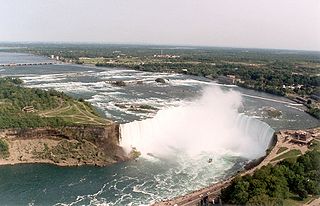
In geomorphology, a knickpoint or nickpoint is part of a river or channel where there is a sharp change in channel slope, such as a waterfall or lake. Knickpoints reflect different conditions and processes on the river, often caused by previous erosion due to glaciation or variance in lithology. In the cycle of erosion model, knickpoints advance one cycle upstream, or inland, replacing an older cycle. A knickpoint that occurs at the head of a channel is called a headcut. Headcuts resulting in headward erosion are hallmarks of unstable expanding drainage features such as actively eroding gullies.
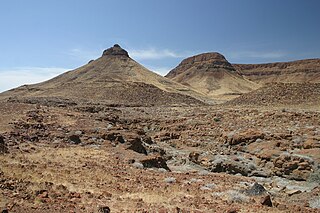
In geology and geomorphology a pediplain is an extensive plain formed by the coalescence of pediments. The processes through which pediplains forms is known as pediplanation. The concepts of pediplain and pediplanation were first developed by geologist Lester Charles King in his 1942 book South African Scenery. The concept gained notoriety as it was juxtaposed to peneplanation.
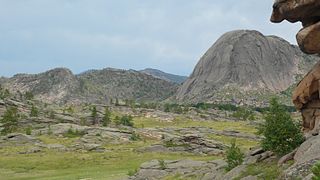
Granite domes are domical hills composed of granite with bare rock exposed over most of the surface. Generally, domical features such as these are known as bornhardts. Bornhardts can form in any type of plutonic rock but are typically composed of granite and granitic gneiss. As granitic plutons cool kilometers below the Earth's surface, minerals in the rock crystallize under uniform confining pressure. Erosion brings the rock closer to Earth's surface and the pressure from above the rock decreases; as a result the rock fractures. These fractures are known as exfoliation joints, or sheet fractures, and form in onionlike patterns that are parallel to the land surface. These sheets of rock peel off the exposed surface and in certain conditions develop domical structures. Additional theories on the origin of granite domes involve scarp-retreat and tectonic uplift.

Sediment transport is the movement of solid particles (sediment), typically due to a combination of gravity acting on the sediment, and/or the movement of the fluid in which the sediment is entrained. Sediment transport occurs in natural systems where the particles are clastic rocks, mud, or clay; the fluid is air, water, or ice; and the force of gravity acts to move the particles along the sloping surface on which they are resting. Sediment transport due to fluid motion occurs in rivers, oceans, lakes, seas, and other bodies of water due to currents and tides. Transport is also caused by glaciers as they flow, and on terrestrial surfaces under the influence of wind. Sediment transport due only to gravity can occur on sloping surfaces in general, including hillslopes, scarps, cliffs, and the continental shelf—continental slope boundary.

Sheet erosion or sheet wash is the even erosion of substrate along a wide area. It occurs in a wide range of settings such as coastal plains, hillslopes, floodplains, beaches, savanna plains and semi-arid plains. Water moving fairly uniformly with a similar thickness over a surface is called sheet flow, and is the cause of sheet erosion. Sheet erosion implies that any flow of water that causes the erosion is not canalized. If a hillslope surface contains many irregularities, sheet erosion may give way to erosion along small channels called rills, which can then converge forming gullies. However, sheet erosion may occur despite some limited unevenness in the sheet flow arising from clods of earth, rock fragments, or vegetation.

A pediment, also known as a concave slope or waning slope, is a very gently sloping (0.5°-7°) inclined bedrock surface. It is typically a concave surface sloping down from the base of a steeper retreating desert cliff, escarpment, or surrounding a monadnock or inselberg, but may persist after the higher terrain has eroded away.

Bank erosion is the wearing away of the banks of a stream or river. This is distinguished from erosion of the bed of the watercourse, which is referred to as scour.

Scarp retreat is a geological process through which the location of an escarpment changes over time. Typically the cliff is undermined, rocks fall and form a talus slope, the talus is chemically or mechanically weathered and then removed through water or wind erosion, and the process of undermining resumes. Scarps may retreat for tens of kilometers in this way over relatively short geological time spans, even in arid locations.
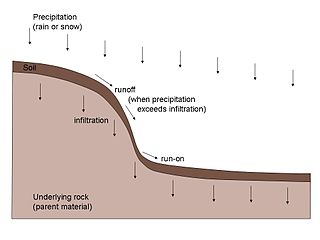
A catena in soil science (pedology) is a series of distinct but co-evolving soils arrayed down a slope. Each soil type or "facet" differs somewhat from its neighbours, but all occur in the same climate and on the same underlying parent material. A mature catena is in equilibrium as the processes of deposition and erosion are in balance.
A geomorphological system said to be in dynamic steady state has values that oscillate between maxima and minima around a central mean value.
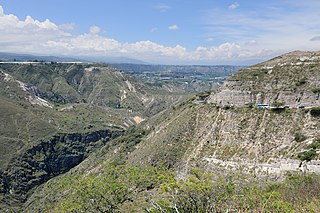
River incision is the narrow erosion caused by a river or stream that is far from its base level. River incision is common after tectonic uplift of the landscape. Incision by multiple rivers result in a dissected landscape, for example a dissected plateau. River incision is the natural process by which a river cuts downward into its bed, deepening the active channel. Though it is a natural process, it can be accelerated rapidly by human factors including land use changes such as timber harvest, mining, agriculture, and road and dam construction. The rate of incision is a function of basal shear-stress. Shear stress is increased by factors such as sediment in the water, which increase its density. Shear stress is proportional to water mass, gravity, and WSS:

Tillage erosion is a form of soil erosion occurring in cultivated fields due to the movement of soil by tillage. There is growing evidence that tillage erosion is a major soil erosion process in agricultural lands, surpassing water and wind erosion in many fields all around the world, especially on sloping and hilly lands A signature spatial pattern of soil erosion shown in many water erosion handbooks and pamphlets, the eroded hilltops, is actually caused by tillage erosion as water erosion mainly causes soil losses in the midslope and lowerslope segments of a slope, not the hilltops. Tillage erosion results in soil degradation, which can lead to significant reduction in crop yield and, therefore, economic losses for the farm.
References
- 1 2 3 4 5 Summerfield, Michael A. (1991). "Exogenic processes and landforms". Global Geomorphology: An introduction to the study of landforms. Pearson Education. pp. 184–185. ISBN 0-582-30156-4.
- ↑ Paul, K (2023-06-28). "Slope Decline Theory by W.M. Davis". Studyprobe. Retrieved 2023-07-02.
{{cite web}}: CS1 maint: url-status (link) - ↑ "Slope Replacement Theory by Walther Penck". Studyprobe. 2023-06-29. Retrieved 2023-07-02.
{{cite web}}: CS1 maint: url-status (link) - ↑ Bremer, Hanna (1983). "Albrecht Penck (1858-1945) and Walther Penck (1888-1923), two german geomorphologists". Zeitschrift für Geomorphologie . 27 (2): 129.
- 1 2 Twidale, C.R. (1992), "King of the plains: Lester King's contributions to geomorphology", Geomorphology , 5 (6): 491–509, Bibcode:1992Geomo...5..491T, doi:10.1016/0169-555x(92)90021-f
- ↑ King, L.C. (1953). "Canons of landscape evolution". Geological Society of America Bulletin. 64 (7): 721–752. Bibcode:1953GSAB...64..721K. doi:10.1130/0016-7606(1953)64[721:cole]2.0.co;2.
- ↑ Huggett, p. 440
- 1 2 Twidale, C.R. (1993). "C.H. Crickmay, a Canadian rebel". Geomorphology . 6 (4): 357–372. Bibcode:1993Geomo...6..357T. doi:10.1016/0169-555x(93)90055-7.
- 1 2 3 4 5 6 Roering, Joshua J.; Kirchner, James W.; Dietrich, William E. (2001). "Hillslope evolution by nonlinear, slope-dependent transport: Steady state morphology and equilibrium adjustment timescales". Journal of Geophysical Research. 106 (B8): 16499–16513. Bibcode:2001JGR...10616499R. doi: 10.1029/2001jb000323 .
- ↑ Culling, W.E.H. (1960). "Analytical Theory of Erosion". The Journal of Geology . 68 (3): 336–344. Bibcode:1960JG.....68..336C. doi:10.1086/626663. S2CID 128740332.
- 1 2 Simons, Martin (1962), "The morphological analysis of landforms: A new review of the work of Walther Penck (1888-1923)", Transactions and Papers (Institute of British Geographers), 31: 1–14, doi:10.2307/621083, JSTOR 621083
- ↑ Chorley et al., p. 790
- ↑ Fernandes, Nelson F.; Dietrich, William E. (1997). "Hillslope evolution by diffusive processes: The timescale for equilibrium adjustments". Water Resources Research. 33 (6): 1307–1318. Bibcode:1997WRR....33.1307F. doi: 10.1029/97wr00534 .
- 1 2 Riggins, Susan G.; Anderson, Robert S.; Prestrud Anderson, Suzanne; Tye, Andrew M. (2011). "Solving a conundrum of a steady-state hilltop with variable soil depths and production rates, Bodmin Moor, UK". Geomorphology. 128 (1–2): 73–84. Bibcode:2011Geomo.128...73R. doi:10.1016/j.geomorph.2010.12.023.
- ↑ Linton, David L. (1955). "The problem of tors". The Geographical Journal . 121 (4): 470–487. doi:10.2307/1791756. JSTOR 1791756.
- ↑ Anderson, Robert S. (2002). "Modeling the tor-dotted crests, bedrock edges, and parabolic profiles of high alpine surfaces of the Wind River Range, Wyoming". Geomorphology. 46 (1–2): 35–58. Bibcode:2002Geomo..46...35A. doi:10.1016/s0169-555x(02)00053-3.
- Bibliography
- Chorley, Richard J.; Beckinsale, Robert P.; Dunn, Antony J. (2005) [1973]. "Chapter Twenty-Two". The History of the Study of Landforms. Vol. Two. Taylor & Francis e-Library.
- Hugget, Richard John (2011) [2002]. "Landscape evolution: Long term geomorphology". Fundamentals of Geomorphology (3rd ed.). Routledge. ISBN 978-0-203-86008-3.